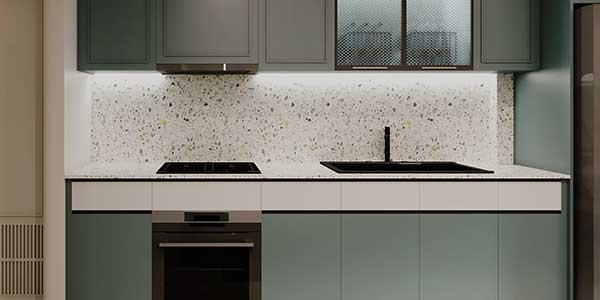Diore Terrazzo
Welcome to our exquisite collection of Terrazzo Worktops, where timeless elegance meets artistic craftsmanship. Terrazzo is a captivating surface material that has graced architectural marvels throughout history. Characterised by its alluring blend of marble, granite, or quartz chips, Terrazzo boasts a unique and eye-catching appearance that adds a touch of sophistication to any space.
Timeless Elegance
Terrazzo worktops exude timeless elegance with their unique and eye-catching appearance. The blend of crushed natural stones, such as marble, granite, or quartz, creates a stunning mosaic-like surface that complements both classic and modern interior styles.
Durability & Longevity
Terrazzo is a highly durable material, making it an excellent choice for worktops that endure daily use and heavy traffic. Its strong composition and resistance to wear, scratches, and stains ensure that Terrazzo worktops maintain their beauty and functionality for years to come.
Versatility
Terrazzo offers a wide range of design possibilities, allowing for customisation to suit individual preferences and design visions. The availability of various aggregates, colours, and binders allows for creating unique patterns and styles that can seamlessly blend into any space.
Eco-Friendly
The use of recycled materials and sustainable manufacturing processes make Terrazzo a green choice for those seeking eco-conscious solutions. Additionally, its longevity and low-maintenance nature contribute to reduced environmental impact over the long term.
What is Terrazzo?
Terrazzo is a composite material that combines a base of cement, epoxy, or resin with an artful mosaic of crushed natural stones, such as marble, granite, or quartz, and sometimes glass or metal pieces. This fusion of exquisite elements lends Terrazzo its signature speckled and textured look, creating a surface that is as durable as it is visually stunning.
Indulge in the timeless beauty of Terrazzo and bring an enduring piece of history into your living spaces. Browse our collection of Terrazzo Worktops and discover a material that epitomizes both artistic expression and functional durability.
Diore Terrazzo Colour Range
Terrazzo’s Long History
The history of Terrazzo dates back to ancient times, with its origins rooted in Italy. The word “Terrazzo” is derived from the Italian word “terra,” which means “earth” or “ground.” Terrazzo was initially developed as a practical and cost-effective solution for flooring in homes and public buildings.
Ancient Terrazzo: The earliest forms of Terrazzo can be traced back to ancient Egypt and Mesopotamia, where artisans used a mixture of lime, clay, and crushed stones to create durable and decorative surfaces. The technique eventually spread to ancient Greece, where it evolved into “Terrazzino,” a type of mosaic flooring made from fragments of marble set in a cementitious binder.
Venetian Terrazzo: Terrazzo, as we know it today, gained popularity during the Venetian Renaissance in the 15th century. Venetian construction workers discovered a way to reuse discarded marble chips from upscale projects by embedding them in clay and then polishing the surface to create smooth and elegant flooring. This method not only reduced waste but also resulted in beautiful and cost-effective flooring solutions. The new technique was known as “Terrazzo alla Veneziana” or “Venetian Terrazzo.”
Terrazzo in Europe and Beyond: The popularity of Terrazzo continued to grow in Europe during the 18th and 19th centuries. Skilled artisans refined the technique, incorporating a wider range of colored stones and experimenting with different binders. Terrazzo became a symbol of luxury and grandeur, adorning the floors of palaces, churches, and prestigious public buildings.
Terrazzo in the United States: In the late 19th century, Terrazzo found its way to the United States through Italian immigrants. It gained widespread popularity in the early to mid-20th century as a flooring material for commercial and public buildings. During this time, Terrazzo expanded beyond flooring, with artisans creating stunning Terrazzo artworks and intricate designs in walls, staircases, and even furniture.
Modern Revival: Terrazzo experienced a resurgence in popularity in the late 20th and early 21st centuries, as designers and architects embraced its versatility and unique aesthetic appeal. Today, Terrazzo is not only used for flooring but also for countertops, wall claddings, and various decorative elements.
Terrazzo continues to be appreciated for its durability, sustainability, and distinctive appearance. Its rich history and artistic legacy have secured its position as a timeless and beloved material in both traditional and contemporary architecture and design.







































